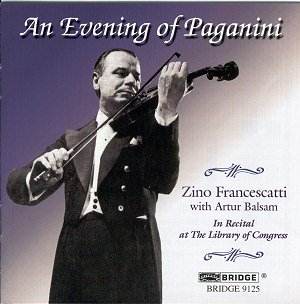The latest release in Bridge’s archive
material of live concerts from The Library of Congress brings to the
fore Zino Francescatti in a recital dating from 1954. He was teamed
with Artur Balsam, born in 1906, and four years younger than his violinist
partner. Balsam has already made several appearances in this series
as either sonata partner of Nathan Milstein or alongside the Budapest
Quartet. Francescatti was fifty-two and at the height of his fame. Though
he was a contemporary of Heifetz – actually a year younger – Francescatti
has always seemed very much younger and the reason seems to have been
the telescoping of his international career. Heifetz sprang to fame
as a teenager but it took the Frenchman much longer to establish his
career - by which time Heifetz had enjoyed comfortable celebrity for
over two decades. Though Francescatti made recordings in 1921 (last
available on Biddulph) he wasn’t to tour America
until 1939, having previously confined himself to a European career.
It wasn’t until the War’s end that his career really took off.
He had studied with his father,
an Italian violinist who had himself studied
with Camillo Sivori, reputedly Paganini’s only pupil. Francescatti had
a considerable affinity with Paganini and in 1947 recorded eight of
the Caprices for Columbia (Nos 9, 13,
14, 15, 20, 21 and 22) with Balsam in the then fashionably spurious
piano accompanied versions, in arrangements by Mario Pilati. I Palpiti
was committed to disc, again with Balsam, two years later. The Carnival
of Venice variations, similarly with Balsam, were recorded in April
1954 in a limited edition for Columbia (PE 19) though
I’m not sure how much publicity this received. Unusually Bridge doesn’t
date this Library of Congress recital – all of their other recitals
are precisely dated – but it must have been quite near the Columbia recording
date, which was April 30th 1954. As
for the Concerto, Francescatti’s recording with the Philadelphia and Ormandy
was a much-admired traversal, dating from January 1950 (sleeve-note
writer Eric Wen in his otherwise excellent notes is mistaken in ascribing
the accompaniment to Mitropoulos and the New York Philharmonic).
The recital highlights all Francescatti’s
greatest qualities; technically magnificent, tonally expressive, lyric
and with exceptional elegance. He possessed a very fast vibrato and
one - as has been often noted – of some considerable oscillation (though
not at all analogous to, say, Ruggiero Ricci’s or to the older generation
of French violinists whose employment of finger tip vibrato led to nanny
goat tonal production. Renée Chemet, born only fourteen years before
Francescatti, is the most obvious example). So whilst this recital is
ancillary to Francescatti’s commercial discography it is still tremendously
exciting to hear the piano-accompanied Concerto and the 17th
Caprice (otherwise unrecorded by him). He starts the Concerto a little
slowly but we can hear some fabulous electric trills, harmonics superbly
in tune – Francescatti’s intonation was invariably dead centre – and
his unflappable concentration in the face of an off-stage crash. His
fast vibrato is powerfully suited to the work and his flying staccatos
are thrown off with devilish precision. He is elegant in the Carnival
of Venice but also full of flair and drive. The pizzicati episode might
turn many a violinist green with envy, even now. The Caprices differ
from the commercially recognised performances inasmuch as Francescatti
uses his own arrangements for Nos. 13, 17 and 24 – and these are all
ringing and characterful performances, bringing out the lyric possibilities
of the individual pieces. No. 15 is especially successful in its terpsichorean
panache and he drives No. 21, the A major, to a drama fuelled conclusion.
His bowing in No. 9 is remarkable and the only slight disappointment
his own rather pat ending to No. 24. I Palpiti is similarly negotiated with the utmost in lyric panache. As
ever with Francescatti, beauty of tone is never lost, no matter how
perilous the demands placed upon him.
Fiddle fanciers won’t hesitate;
those who know Francescatti’s Concerto with Ormandy may not have the
1947 Caprices. But there isn’t a huge amount of live Francescatti around
and as far as I’m concerned you can never have too much of a good thing.
Jonathan Woolf
